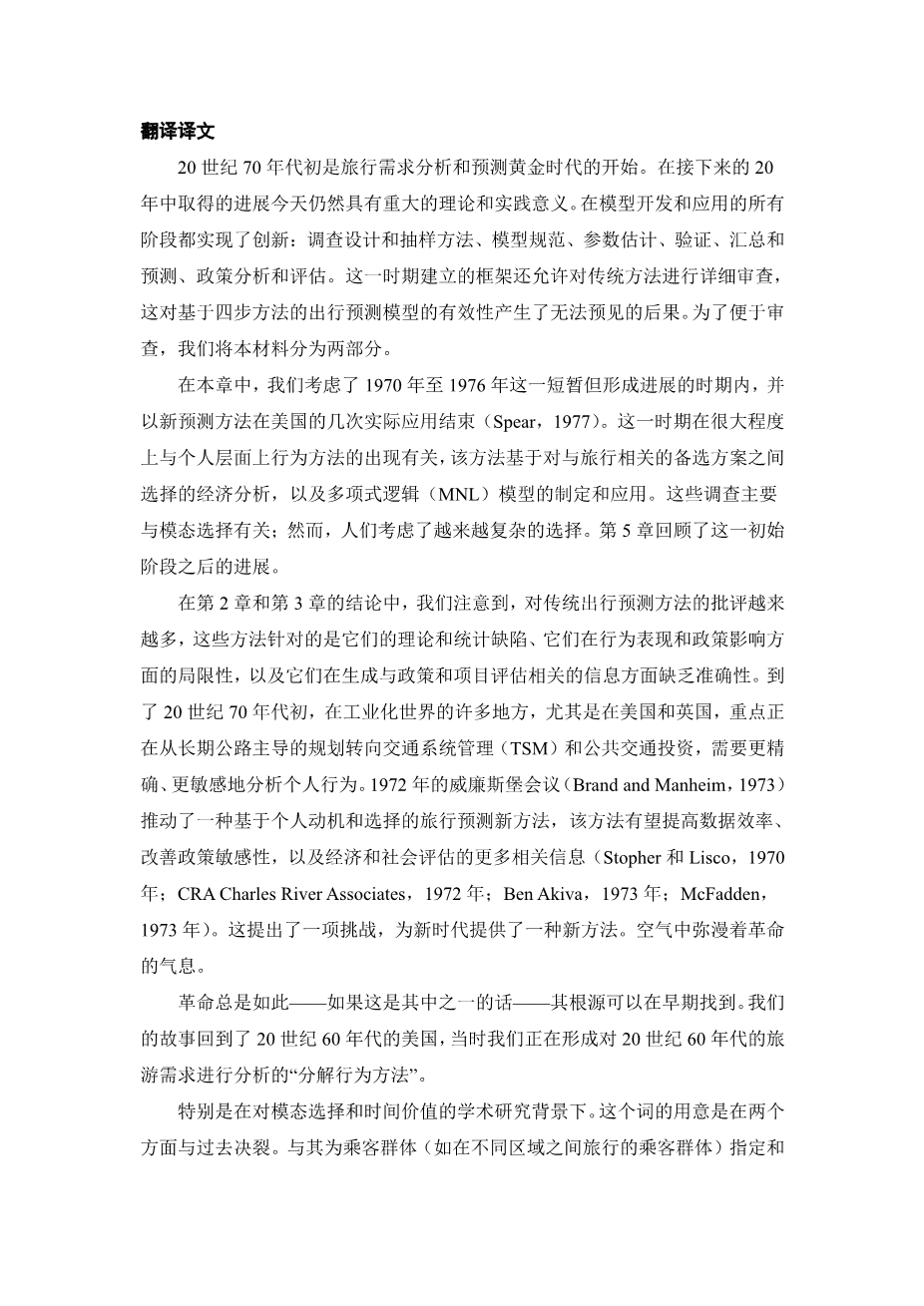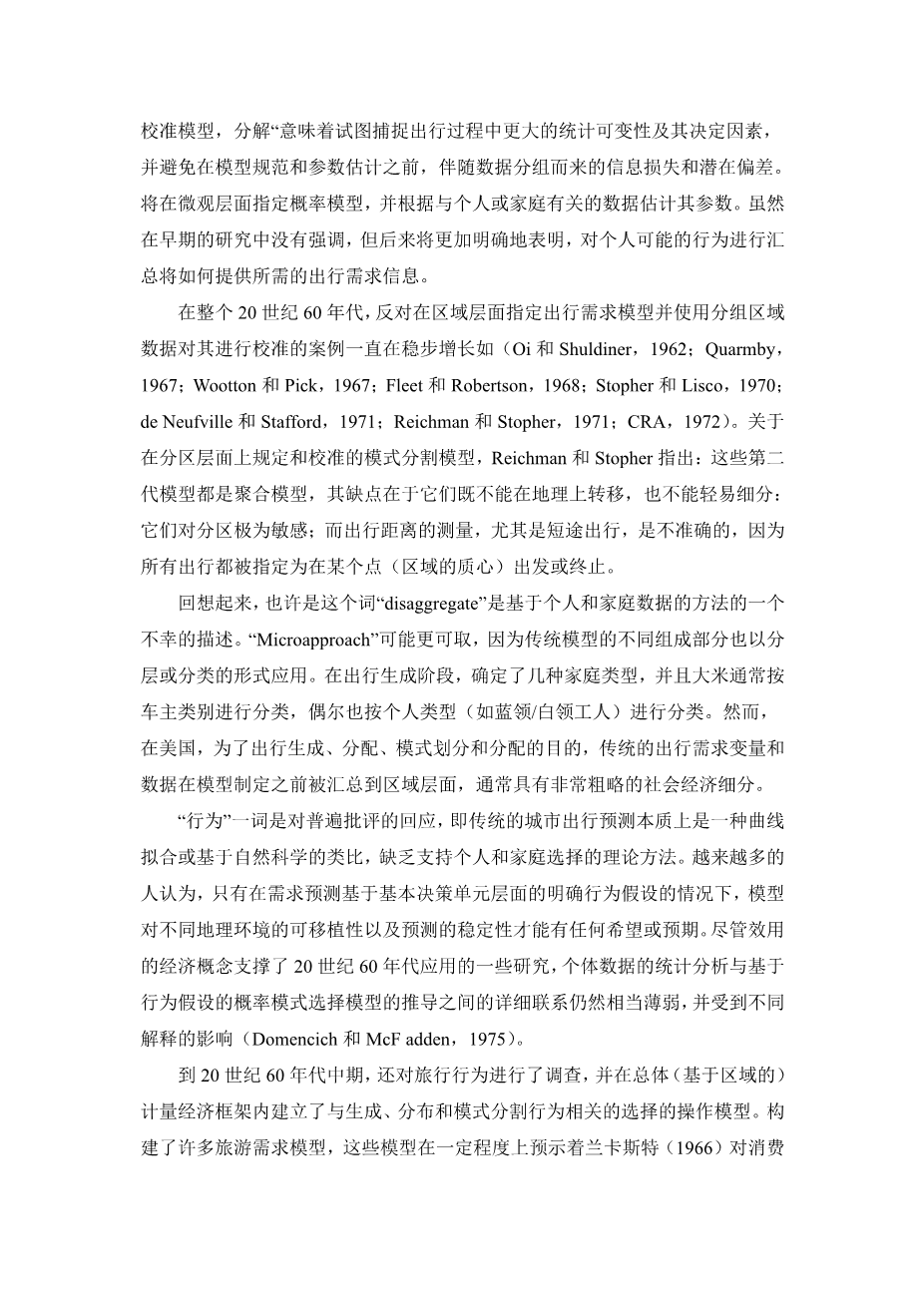兴隆村至抚民村公路工程施工图设计外文翻译资料
2023-04-08 22:49:40
翻译原文
The early 1970s was the beginning of a golden age for travel demand analysis and forecasting. Progress made in the following two decades still has major theoretical and practical relevance today. Innovations were achieved in all phases of model development and application: survey design and sampling methods, model specification, parameter estimation, validation, aggregation, and forecasting, policy analysis and evalu ation. The framework established in this period also allowed traditional methods to be subjected to detailed scrutiny, which had quite unforeseen consequences for the validity of travel forecasting models based on the four-step approach. For the purposes of our review,we divide this material into two parts.
In this chapter we consider advances in the short but formative period 1970- 76, ending with several practical applications of the new forecasting methods in the US (Spear, 1977). This period is largely associated with the emergence of a behavioural approach at the individual level, based on the economic analysis of choice between travel-related alternatives, and the formulation and application of the multinomial logit (MNL) model. These investigations were mainly associated with modal choice; however, increasingly complex choices were considered. Advances following this initial period are reviewed in Chapter 5.
At the conclusions to Chapters 2 and 3, we noted the rising criticism of traditional travel forecasting methods which was directed at their theoretical and statistical deficiencies, their limitations in the representation of behaviour and the effects of policies, and their lack of precision in generating information of relevance to the evaluation of policies and projects. By the early 1970s, in many parts of the industrialised world and in particular in the US and the UK, emphasis was changing from long-range highway dominated planning towards transportation system management (TSM) and public transport investment, requiring analyses of greater precision and more sensitive to the behaviour of individuals. The Williamsburg conference in 1972 (Brand and Manheim, 1973) gave impetus to a new approach to travel forecasting conceived in terms of individual motivation and choice, which held the promise of greater data efficiency, improved policy sensitivity, and more relevant information for economic and social evaluation (Stopher and Lisco, 1970; Charles River Associates, CRA, 1972; Ben-Akiva, 1973; McFadden, 1973). A challenge was laid down that offered a new approach for a new era. The whiff of revolution was in the air.
As is always the case with revolutions - if this was to be one - its roots were to be found in earlier times. Our story returns to the 1960s in the US when the disaggregate behavioural approach to the analysis to the 1960s in the travel demand,introduce at the start of the decade,we taking shape.
Particularly in the context of academic research into modal choice and the value of time (Reichman and Stopher, 1971). The term was intended to signify a break with the past in two respects. Rather than specify and calibrate models for groups of passengers, such as those travelling between zones, disaggregation implied an attempt to capture greater statistical variability in trip making and its determining factors, and avoid information loss and potential bias accompanying the grouping of data prior to model specification and parameter estimation. Probabilistic models would be specified at the micro-level and their parameters estimated from data pertaining to individuals or households. Although not emphasised in the earliest studies, it would later become more explicit how summation over the probable behaviour of individuals would provide the required aggregate travel demand information.
The case against specifying travel demand models at the level of the zone and calibrating them with grouped zonal data had been growing steadily through the 1960s (Oi and Shuldiner, 1962; Quarmby, 1967; Wootton and Pick, 1967; Fleet and Robertson, 1968; Stopher and Lisco, 1970; de Neufville and Stafford, 1971; Reichman and Stopher, 1971; CRA, 1972). In relation to modal split models, specified and calibrated at the zonal level, Reichman and Stopher were to remark: these second generation models are all aggregate models and have drawbacks in that they can neither be transferred geographically nor readily subdivided: they are extremely sensitive to zoning; and the measurements of trip distances, particularly for short trips, are inaccurate because of the aggregation under which all trips are designated as originating or terminating at a point, the centroid of a zone (Reichman and Stopher, 1971,92 -93).
In retrospect, perhaps the term disaggregate was an unfortunate descriptor for an approach based on data pertaining to individuals and households. Microapproach might have been preferable, because different components of traditional models were also applied in a stratified or disaggregated form.Several household types were identified at the trip generation stage, and trip matrices were usually stratified by car owner ship classes and, occasionally, by person type (e. g., blue collar/white collar workers). However, for the purposes of trip generation, distribution, modal split and assignment in the US, traditional travel demand variables and data were aggregated to the zonal level prior to model formulation, typically with a very coarse socioeconomic segmentation.
The term behavioural indicated a response to the common criticism that traditional urban travel forecasting was essentially a curve-fitting exercise or based on analogues from the natural sciences, and lacking a theoretical approach underpinning the choices made by individuals and households. Only if demand forecasts were based on explicit behavioural hypotheses at the level of the fundamental decision-making unit, it was increasi
剩余内容已隐藏,支付完成后下载完整资料


英语译文共 5 页,剩余内容已隐藏,支付完成后下载完整资料
资料编号:[590321],资料为PDF文档或Word文档,PDF文档可免费转换为Word




